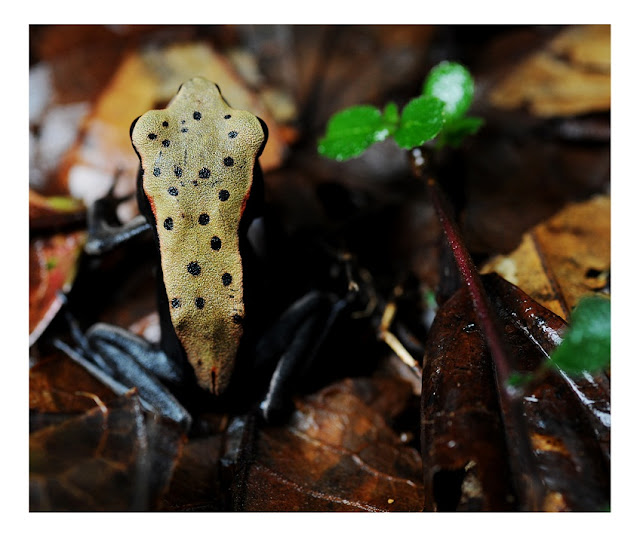
The southwest monsoon has just set in and the entire forest is dripping wet. The dimly lit floor is an abstract mosaic of rust, maroon, brown, beige, green and black – leaves in all stages of decomposition, slowly turning into soggy mulch. An occasional vein of green moss on a tree buttress glows iridescent under a rare shaft of sunlight. Fungi sprout everywhere feasting on death and decay. Every tentative footstep encounters leeches – tiny cold-blooded filaments swaying in the stagnant and humid air, relentlessly in the hunt for the iota of warmth that our feet radiate, setting them off on a determined somersaulting advance. Rotting twigs and branches give way at the slightest footfall and the soft murmur of rain on the dense closed canopy is a permanent hum in a forest which is otherwise silent, at least until nightfall provides the cue to lovesick frogs and crickets.

We are on the lookout for the Hump-nosed Pit Viper but instead we sight the Bicoloured Frog. It, too, is wet and soaked, motionless until it notices us with its large, round, red eyes, which are well adapted to sight in the semi-darkness of the rainforest.
True to its name, the predominant impression of the Bicoloured Frog (Clinotarsus curtipes), is the neat division of the colouration of the upper and the lower halves of its body. The upper half (which has been described as grey or brown) is cream-coloured, tinged with yellow resulting in a very light shade of brown that matches the surrounding leaf litter. The lower half of the body is glistening black with no banding on the limbs. Seen in dimmer light the glistening back gives the impression of deep beige.
The nostrils are very close to the mouth and the tympanum, present on the black half of the body and hence not very easily seen, is as large as the eye. The size is approximately 7 cm and the snout is pointed. The backs of all the four or five frogs that we encountered bore randomly distributed black spots, providing excellent camouflage in the leaf litter. The spotting on the back may or may not be present on individual frogs though all the frogs that we encountered had them.
True to its name, the predominant impression of the Bicoloured Frog (Clinotarsus curtipes), is the neat division of the colouration of the upper and the lower halves of its body. The upper half (which has been described as grey or brown) is cream-coloured, tinged with yellow resulting in a very light shade of brown that matches the surrounding leaf litter. The lower half of the body is glistening black with no banding on the limbs. Seen in dimmer light the glistening back gives the impression of deep beige.
The nostrils are very close to the mouth and the tympanum, present on the black half of the body and hence not very easily seen, is as large as the eye. The size is approximately 7 cm and the snout is pointed. The backs of all the four or five frogs that we encountered bore randomly distributed black spots, providing excellent camouflage in the leaf litter. The spotting on the back may or may not be present on individual frogs though all the frogs that we encountered had them.

While we photographed the frog – almost lying on the ground for an eye-level view (an act of extreme gallantry considering the omnipresent, ever-flipping thirsty-for-blood leeches) the frog was moderately alarmed and tried to move away, on one occasion walking up using its limbs, but was not unduly shy, never taking more than one hop. Clinotarsus curtipes seemed to be fairly common but none happened to be in breeding colors yet.

The IUCN status is Near Threatened, primarily on account of habitat loss. Clinotarsus curtipes is a terrestrial leaf-litter frog but has webbed toes and enters the water only during the breeding season. It adapts well and is found in different forest types -- evergreen, semi-evergreen and deciduous. In the breeding season the frog acquires a ruddy disposition with the black receding out from the sides and the underside becoming very dark, almost black. The vocal sac is internal. As in a lot of frog species the female is larger than the male. J C Daniel notes that the dispersal of young frogs is very orderly and almost battalion-like.
The spots, like the stripes of the tiger, can be distinctive and are used to identify individual frogs during density surveys. The spots are also a good aid to locate the frog since an uncannily well synchronised set of polka dots hopping on the forest floor give away an otherwise excellent camouflage.

Read more Agumbe Diaries
Text and photographs by Sahastrarashmi
Photograph of the breeding male by L Shyamal (Wikipedia Commons)


